
Previous in Probability and Statistics Next in Probability and Statistics
Question Number 178626 by mr W last updated on 19/Oct/22
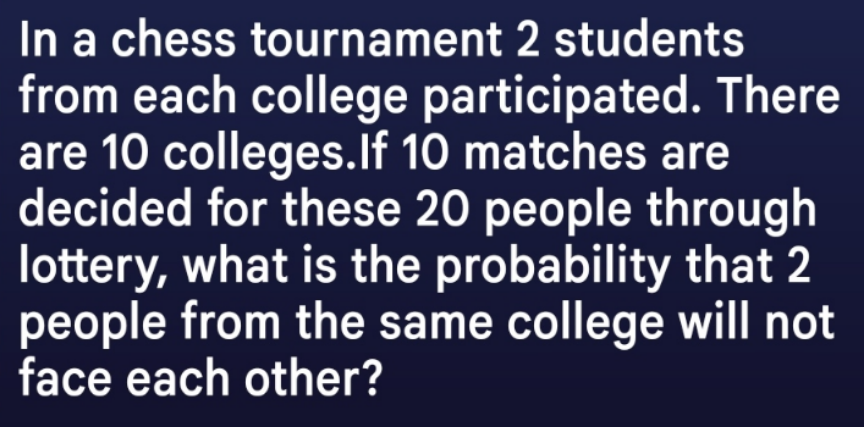
Commented by Frix last updated on 20/Oct/22
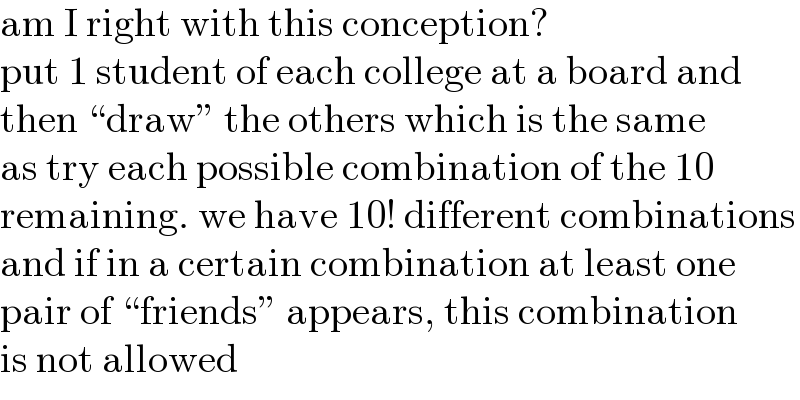
$$\mathrm{am}\:\mathrm{I}\:\mathrm{right}\:\mathrm{with}\:\mathrm{this}\:\mathrm{conception}? \\ $$$$\mathrm{put}\:\mathrm{1}\:\mathrm{student}\:\mathrm{of}\:\mathrm{each}\:\mathrm{college}\:\mathrm{at}\:\mathrm{a}\:\mathrm{board}\:\mathrm{and} \\ $$$$\mathrm{then}\:``\mathrm{draw}''\:\mathrm{the}\:\mathrm{others}\:\mathrm{which}\:\mathrm{is}\:\mathrm{the}\:\mathrm{same} \\ $$$$\mathrm{as}\:\mathrm{try}\:\mathrm{each}\:\mathrm{possible}\:\mathrm{combination}\:\mathrm{of}\:\mathrm{the}\:\mathrm{10} \\ $$$$\mathrm{remaining}.\:\mathrm{we}\:\mathrm{have}\:\mathrm{10}!\:\mathrm{different}\:\mathrm{combinations} \\ $$$$\mathrm{and}\:\mathrm{if}\:\mathrm{in}\:\mathrm{a}\:\mathrm{certain}\:\mathrm{combination}\:\mathrm{at}\:\mathrm{least}\:\mathrm{one} \\ $$$$\mathrm{pair}\:\mathrm{of}\:``\mathrm{friends}''\:\mathrm{appears},\:\mathrm{this}\:\mathrm{combination} \\ $$$$\mathrm{is}\:\mathrm{not}\:\mathrm{allowed} \\ $$
Commented by Frix last updated on 20/Oct/22

$$\mathrm{I}\:\mathrm{wrote}\:\mathrm{a}\:\mathrm{simulation}\:\mathrm{program}\:\mathrm{and}\:\mathrm{got} \\ $$$${p}\approx\mathrm{36}.\mathrm{82\%}\pm\mathrm{1}.\mathrm{78\%} \\ $$$$\mathrm{with}\:\mathrm{a}\:\mathrm{confidence}\:\mathrm{of}\:\mathrm{99}.\mathrm{95\%}\:\mathrm{at}\:{n}=\mathrm{9000} \\ $$$$\mathrm{this}\:\mathrm{would}\:\mathrm{be}\:\frac{\mathrm{7}}{\mathrm{19}} \\ $$
Commented by MJS_new last updated on 24/Oct/22
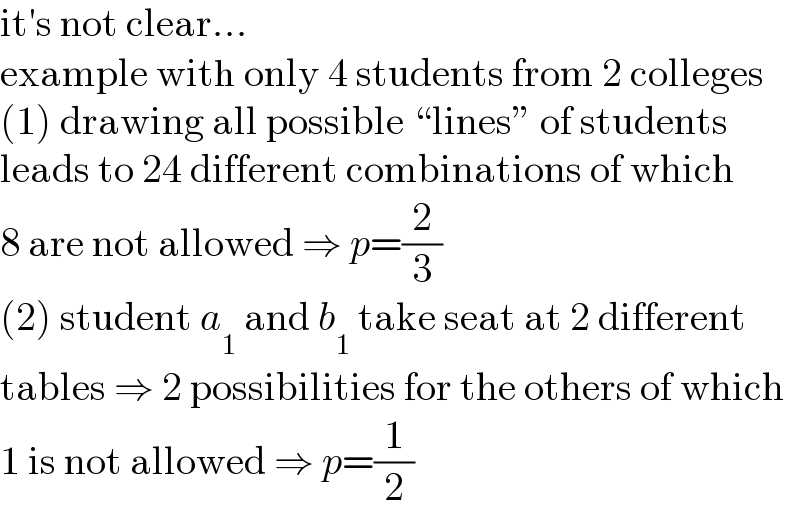
$$\mathrm{it}'\mathrm{s}\:\mathrm{not}\:\mathrm{clear}... \\ $$$$\mathrm{example}\:\mathrm{with}\:\mathrm{only}\:\mathrm{4}\:\mathrm{students}\:\mathrm{from}\:\mathrm{2}\:\mathrm{colleges} \\ $$$$\left(\mathrm{1}\right)\:\mathrm{drawing}\:\mathrm{all}\:\mathrm{possible}\:``\mathrm{lines}''\:\mathrm{of}\:\mathrm{students} \\ $$$$\mathrm{leads}\:\mathrm{to}\:\mathrm{24}\:\mathrm{different}\:\mathrm{combinations}\:\mathrm{of}\:\mathrm{which} \\ $$$$\mathrm{8}\:\mathrm{are}\:\mathrm{not}\:\mathrm{allowed}\:\Rightarrow\:{p}=\frac{\mathrm{2}}{\mathrm{3}} \\ $$$$\left(\mathrm{2}\right)\:\mathrm{student}\:{a}_{\mathrm{1}} \:\mathrm{and}\:{b}_{\mathrm{1}} \:\mathrm{take}\:\mathrm{seat}\:\mathrm{at}\:\mathrm{2}\:\mathrm{different} \\ $$$$\mathrm{tables}\:\Rightarrow\:\mathrm{2}\:\mathrm{possibilities}\:\mathrm{for}\:\mathrm{the}\:\mathrm{others}\:\mathrm{of}\:\mathrm{which} \\ $$$$\mathrm{1}\:\mathrm{is}\:\mathrm{not}\:\mathrm{allowed}\:\Rightarrow\:{p}=\frac{\mathrm{1}}{\mathrm{2}} \\ $$
Answered by Acem last updated on 19/Oct/22

$$ \\ $$$${P}_{\mathrm{2}{p}\:{fr}.{sm}.{colg}.{not}\:{play}} =\:\frac{\mathrm{18}}{\mathrm{19}} \\ $$
Commented by Acem last updated on 19/Oct/22

$${That}'{s}\:{as}\:{i}\:{understood}\:{that}\:{there}\:{are}\:{only}\:\mathrm{10} \\ $$$$\:{matches}. \\ $$
Commented by Frix last updated on 19/Oct/22

$$\mathrm{I}\:\mathrm{think}\:\mathrm{it}\:\mathrm{should}\:\mathrm{be}\:\mathrm{around}\:\mathrm{33\%},\:\mathrm{maybe} \\ $$$$\mathrm{a}\:\mathrm{bit}\:\mathrm{more}\:\mathrm{but}\:\frac{\mathrm{18}}{\mathrm{19}}\approx\mathrm{94}.\mathrm{74\%}\:\mathrm{seems}\:\mathrm{too}\:\mathrm{much} \\ $$
Commented by Acem last updated on 19/Oct/22

$${A}\:{game}\:{between}\:{two}\:{students}\:{from}\:{same}\:{college} \\ $$$$\:{must}\:{be}\:{low}\:{in}\:{front}\:{of}\:{each}\:{one}\:{of}\:{them} \\ $$$$\:{may}\:{plays}\:{with}\:{someone}\:{of}\:{other}\:\mathrm{18}\:{students} \\ $$
Commented by mr W last updated on 19/Oct/22
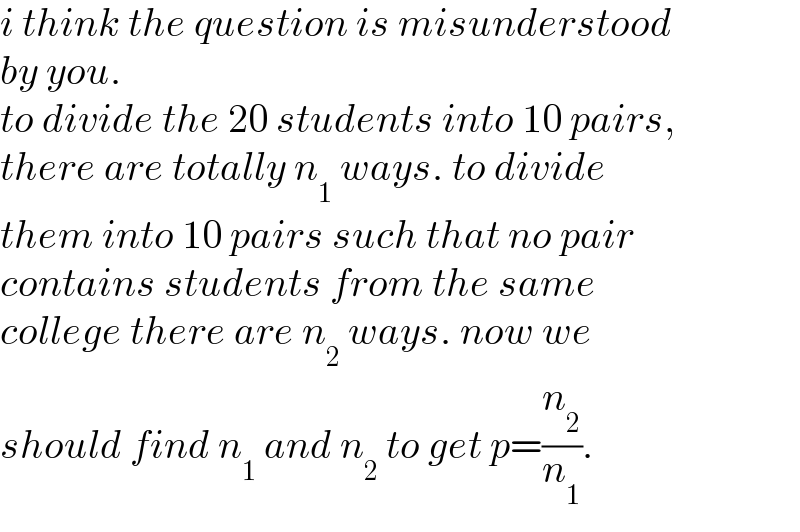
$${i}\:{think}\:{the}\:{question}\:{is}\:{misunderstood} \\ $$$${by}\:{you}. \\ $$$${to}\:{divide}\:{the}\:\mathrm{20}\:{students}\:{into}\:\mathrm{10}\:{pairs}, \\ $$$${there}\:{are}\:{totally}\:{n}_{\mathrm{1}} \:{ways}.\:{to}\:{divide} \\ $$$${them}\:{into}\:\mathrm{10}\:{pairs}\:{such}\:{that}\:{no}\:{pair}\: \\ $$$${contains}\:{students}\:{from}\:{the}\:{same} \\ $$$${college}\:{there}\:{are}\:{n}_{\mathrm{2}} \:{ways}.\:{now}\:{we} \\ $$$${should}\:{find}\:{n}_{\mathrm{1}} \:{and}\:{n}_{\mathrm{2}} \:{to}\:{get}\:{p}=\frac{{n}_{\mathrm{2}} }{{n}_{\mathrm{1}} }. \\ $$
Commented by Acem last updated on 20/Oct/22

$${Yes}\:{i}\:{know}\:{that}\:{as}\:{well} \\ $$
Commented by mr W last updated on 20/Oct/22

$${what}\:{did}\:{you}\:{get}\:{for}\:{n}_{\mathrm{1}} \:{and}\:{n}_{\mathrm{2}} ? \\ $$
Commented by Acem last updated on 20/Oct/22

$$\mathrm{190}\:{paires}\:{represent}\:{n}_{\mathrm{1}} \:,\:{ten}\:{out}\:{of}\:{it}\:{represent} \\ $$$$\:{num}.{of}\:{paires}\:{of}\:{students}\:{from}\:{same}\:{college} \\ $$$$\:{hence}\:\mathrm{180}\:{represent}\:{n}_{\mathrm{2}} \\ $$
Commented by mr W last updated on 20/Oct/22
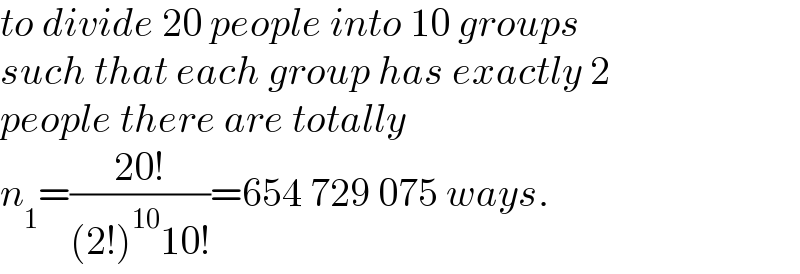
$${to}\:{divide}\:\mathrm{20}\:{people}\:{into}\:\mathrm{10}\:{groups} \\ $$$${such}\:{that}\:{each}\:{group}\:{has}\:{exactly}\:\mathrm{2} \\ $$$${people}\:{there}\:{are}\:{totally} \\ $$$${n}_{\mathrm{1}} =\frac{\mathrm{20}!}{\left(\mathrm{2}!\right)^{\mathrm{10}} \mathrm{10}!}=\mathrm{654}\:\mathrm{729}\:\mathrm{075}\:{ways}. \\ $$
Commented by Acem last updated on 20/Oct/22
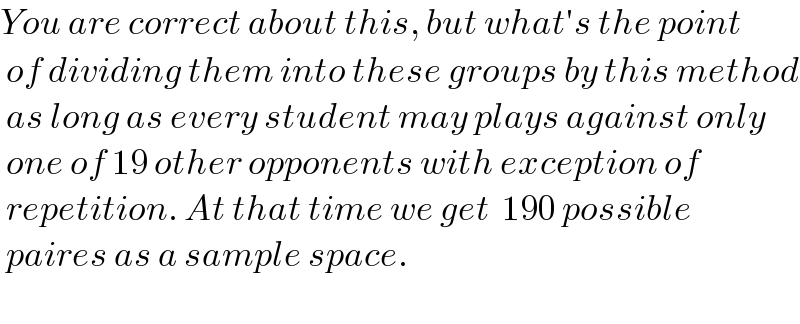
$${You}\:{are}\:{correct}\:{about}\:{this},\:{but}\:{what}'{s}\:{the}\:{point} \\ $$$$\:{of}\:{dividing}\:{them}\:{into}\:{these}\:{groups}\:{by}\:{this}\:{method} \\ $$$$\:{as}\:{long}\:{as}\:{every}\:{student}\:{may}\:{plays}\:{against}\:{only} \\ $$$$\:{one}\:{of}\:\mathrm{19}\:{other}\:{opponents}\:{with}\:{exception}\:{of} \\ $$$$\:{repetition}.\:{At}\:{that}\:{time}\:{we}\:{get}\:\:\mathrm{190}\:{possible} \\ $$$$\:{paires}\:{as}\:{a}\:{sample}\:{space}. \\ $$$$ \\ $$
Commented by Acem last updated on 20/Oct/22
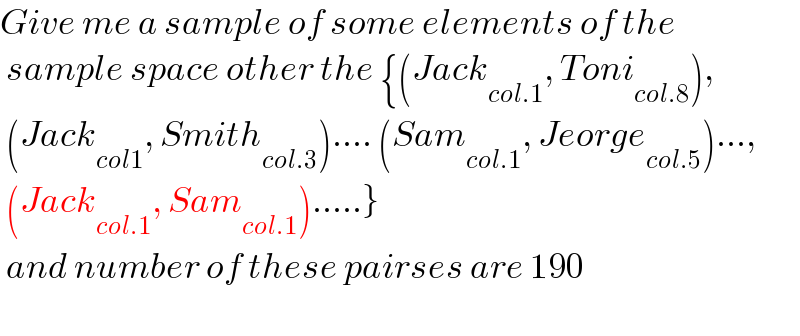
$${Give}\:{me}\:{a}\:{sample}\:{of}\:{some}\:{elements}\:{of}\:{the}\: \\ $$$$\:{sample}\:{space}\:{other}\:{the}\:\left\{\left({Jack}_{{col}.\mathrm{1}} ,\:{Toni}_{{col}.\mathrm{8}} \right),\right. \\ $$$$\:\left({Jack}_{{col}\mathrm{1}} ,\:{Smith}_{{col}.\mathrm{3}} \right)....\:\left({Sam}_{{col}.\mathrm{1}} ,\:{Jeorge}_{{col}.\mathrm{5}} \right)..., \\ $$$$\left.\:\left({Jack}_{{col}.\mathrm{1}} ,\:{Sam}_{{col}.\mathrm{1}} \right).....\right\} \\ $$$$\:{and}\:{number}\:{of}\:{these}\:{pairses}\:{are}\:\mathrm{190} \\ $$$$ \\ $$
Commented by mr W last updated on 20/Oct/22
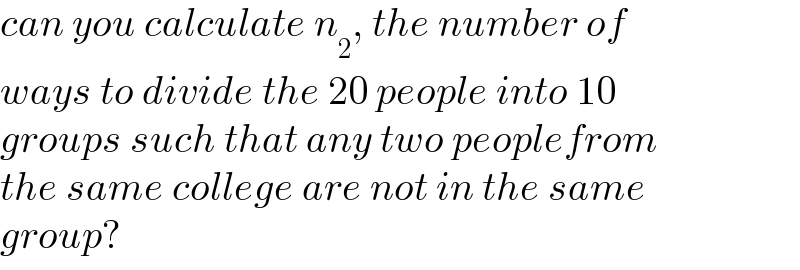
$${can}\:{you}\:{calculate}\:{n}_{\mathrm{2}} ,\:{the}\:{number}\:{of} \\ $$$${ways}\:{to}\:{divide}\:{the}\:\mathrm{20}\:{people}\:{into}\:\mathrm{10} \\ $$$${groups}\:{such}\:{that}\:{any}\:{two}\:{peoplefrom} \\ $$$${the}\:{same}\:{college}\:{are}\:{not}\:{in}\:{the}\:{same} \\ $$$${group}? \\ $$
Commented by Acem last updated on 21/Oct/22
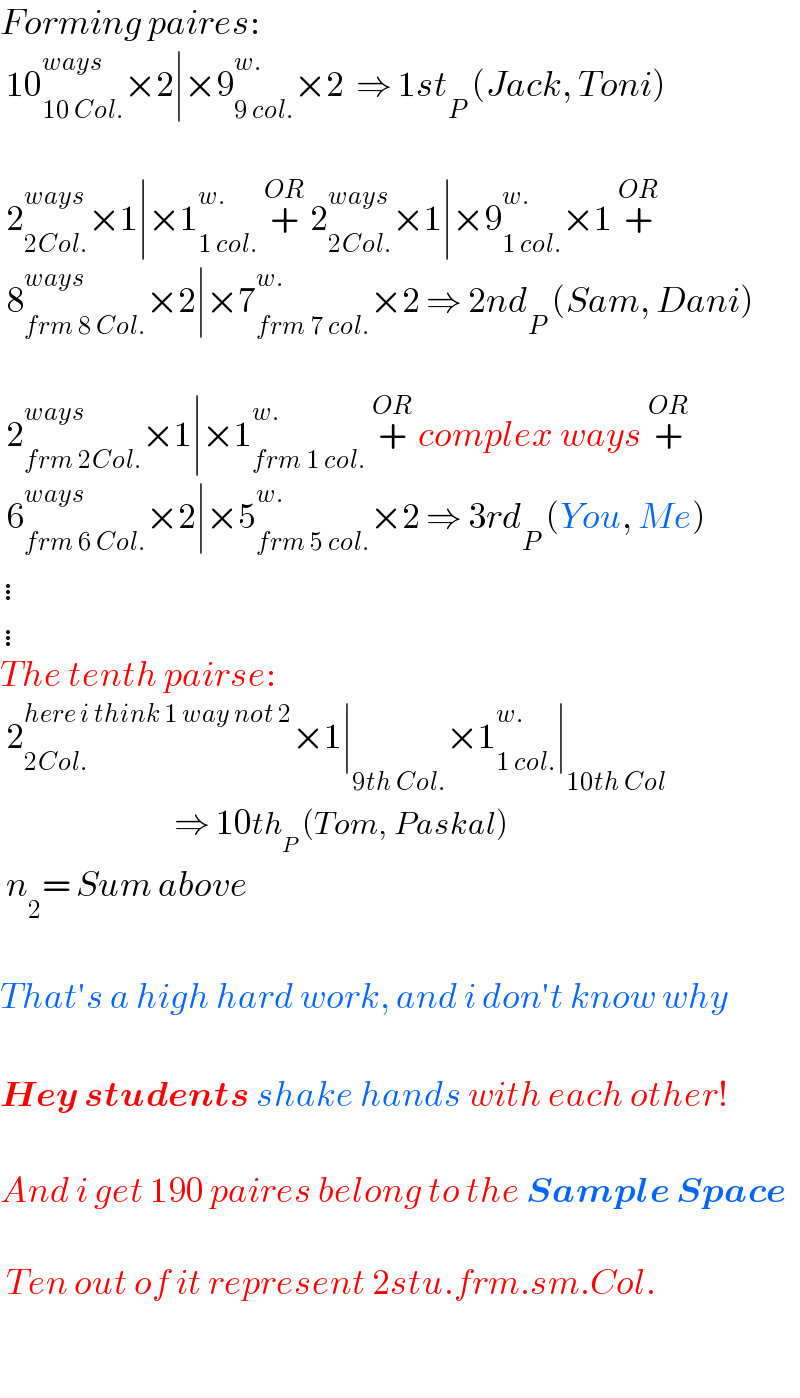
$${Forming}\:{paires}: \\ $$$$\:\mathrm{10}_{\mathrm{10}\:{Col}.} ^{{ways}} ×\mathrm{2}\mid×\mathrm{9}_{\mathrm{9}\:{col}.} ^{{w}.} ×\mathrm{2}\:\:\Rightarrow\:\mathrm{1}{st}_{{P}} \:\left({Jack},\:{Toni}\right) \\ $$$$ \\ $$$$\:\mathrm{2}_{\mathrm{2}{Col}.} ^{{ways}} ×\mathrm{1}\mid×\mathrm{1}_{\mathrm{1}\:{col}.} ^{{w}.} \:\overset{{OR}} {+}\:\mathrm{2}_{\mathrm{2}{Col}.} ^{{ways}} ×\mathrm{1}\mid×\mathrm{9}_{\mathrm{1}\:{col}.} ^{{w}.} ×\mathrm{1}\:\overset{{OR}} {+} \\ $$$$\:\mathrm{8}_{{frm}\:\mathrm{8}\:{Col}.} ^{{ways}} ×\mathrm{2}\mid×\mathrm{7}_{{frm}\:\mathrm{7}\:{col}.} ^{{w}.} ×\mathrm{2}\:\Rightarrow\:\mathrm{2}{nd}_{{P}} \:\left({Sam},\:{Dani}\right) \\ $$$$ \\ $$$$\:\mathrm{2}_{{frm}\:\mathrm{2}{Col}.} ^{{ways}} ×\mathrm{1}\mid×\mathrm{1}_{{frm}\:\mathrm{1}\:{col}.} ^{{w}.} \:\overset{{OR}} {+}\:{complex}\:{ways}\:\overset{{OR}} {+} \\ $$$$\:\mathrm{6}_{{frm}\:\mathrm{6}\:{Col}.} ^{{ways}} ×\mathrm{2}\mid×\mathrm{5}_{{frm}\:\mathrm{5}\:{col}.} ^{{w}.} ×\mathrm{2}\:\Rightarrow\:\mathrm{3}{rd}_{{P}} \:\left({You},\:{Me}\right) \\ $$$$\vdots \\ $$$$\vdots \\ $$$${The}\:{tenth}\:{pairse}: \\ $$$$\:\mathrm{2}_{\mathrm{2}{Col}.} ^{{here}\:{i}\:{think}\:\mathrm{1}\:{way}\:{not}\:\mathrm{2}} ×\mathrm{1}\mid_{\mathrm{9}{th}\:{Col}.} ×\mathrm{1}_{\mathrm{1}\:{col}.} ^{{w}.} \mid_{\mathrm{10}{th}\:{Col}} \\ $$$$\:\:\:\:\:\:\:\:\:\:\:\:\:\:\:\:\:\:\:\:\:\:\:\:\:\:\:\:\:\Rightarrow\:\mathrm{10}{th}_{{P}} \:\left({Tom},\:{Paskal}\right) \\ $$$$\:{n}_{\mathrm{2}} =\:{Sum}\:{above} \\ $$$$\: \\ $$$${That}'{s}\:{a}\:{high}\:{hard}\:{work},\:{and}\:{i}\:{don}'{t}\:{know}\:{why} \\ $$$$ \\ $$$$\boldsymbol{{Hey}}\:\boldsymbol{{students}}\:{shake}\:{hands}\:{with}\:{each}\:{other}! \\ $$$$ \\ $$$${And}\:{i}\:{get}\:\mathrm{190}\:{paires}\:{belong}\:{to}\:{the}\:\boldsymbol{{Sample}}\:\boldsymbol{{Space}} \\ $$$$ \\ $$$$\:{Ten}\:{out}\:{of}\:{it}\:{represent}\:\mathrm{2}{stu}.{frm}.{sm}.{Col}. \\ $$$$ \\ $$$$ \\ $$
Commented by Acem last updated on 21/Oct/22
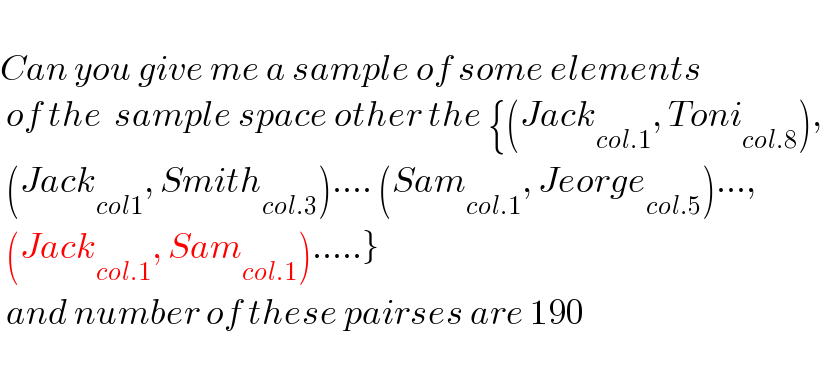
$$ \\ $$$${Can}\:{you}\:{give}\:{me}\:{a}\:{sample}\:{of}\:{some}\:{elements} \\ $$$$\:{of}\:{the}\:\:{sample}\:{space}\:{other}\:{the}\:\left\{\left({Jack}_{{col}.\mathrm{1}} ,\:{Toni}_{{col}.\mathrm{8}} \right),\right. \\ $$$$\:\left({Jack}_{{col}\mathrm{1}} ,\:{Smith}_{{col}.\mathrm{3}} \right)....\:\left({Sam}_{{col}.\mathrm{1}} ,\:{Jeorge}_{{col}.\mathrm{5}} \right)..., \\ $$$$\left.\:\left({Jack}_{{col}.\mathrm{1}} ,\:{Sam}_{{col}.\mathrm{1}} \right).....\right\} \\ $$$$\:{and}\:{number}\:{of}\:{these}\:{pairses}\:{are}\:\mathrm{190} \\ $$$$ \\ $$
Commented by Acem last updated on 21/Oct/22
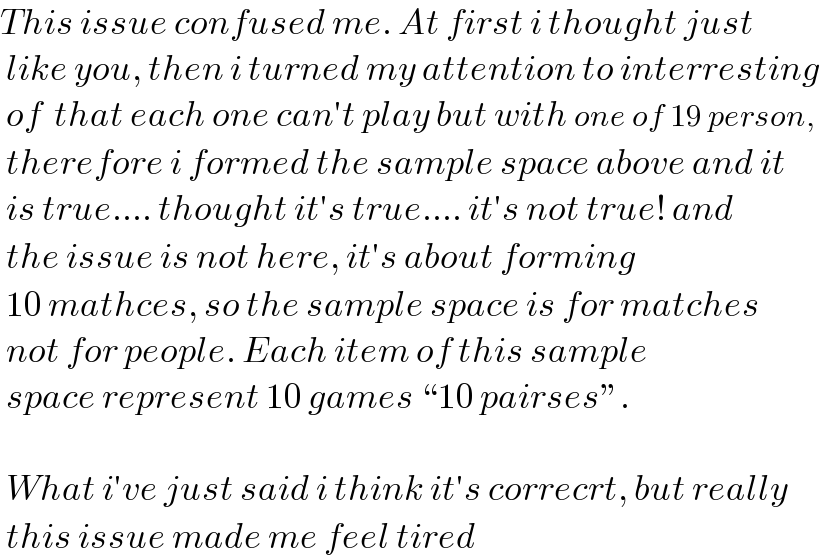
$${This}\:{issue}\:{confused}\:{me}.\:{At}\:{first}\:{i}\:{thought}\:{just} \\ $$$$\:{like}\:{you},\:{then}\:{i}\:{turned}\:{my}\:{attention}\:{to}\:{interresting} \\ $$$$\:{of}\:\:{that}\:{each}\:{one}\:{can}'{t}\:{play}\:{but}\:{with}\:{one}\:{of}\:\mathrm{19}\:{person}, \\ $$$$\:{therefore}\:{i}\:{formed}\:{the}\:{sample}\:{space}\:{above}\:{and}\:{it} \\ $$$$\:{is}\:{true}....\:{thought}\:{it}'{s}\:{true}....\:{it}'{s}\:{not}\:{true}!\:{and} \\ $$$$\:{the}\:{issue}\:{is}\:{not}\:{here},\:{it}'{s}\:{about}\:{forming} \\ $$$$\:\mathrm{10}\:{mathces},\:{so}\:{the}\:{sample}\:{space}\:{is}\:{for}\:{matches} \\ $$$$\:{not}\:{for}\:{people}.\:{Each}\:{item}\:{of}\:{this}\:{sample} \\ $$$$\:{space}\:{represent}\:\mathrm{10}\:{games}\:``\mathrm{10}\:{pairses}''. \\ $$$$ \\ $$$$\:{What}\:{i}'{ve}\:{just}\:{said}\:{i}\:{think}\:{it}'{s}\:{correcrt},\:{but}\:{really} \\ $$$$\:{this}\:{issue}\:{made}\:{me}\:{feel}\:{tired} \\ $$
Commented by mr W last updated on 21/Oct/22

$${this}\:{is}\:{a}\:{very}\:{old}\:{question}\:{in}\:{the}\:{forum} \\ $$$${which}\:{is}\:{not}\:{solved}\:{yet}. \\ $$
Commented by mr W last updated on 21/Oct/22

$${the}\:{answer}\:{should}\:{be}\:{p}\approx\mathrm{0}.\mathrm{55\%}. \\ $$
Commented by MJS_new last updated on 24/Oct/22
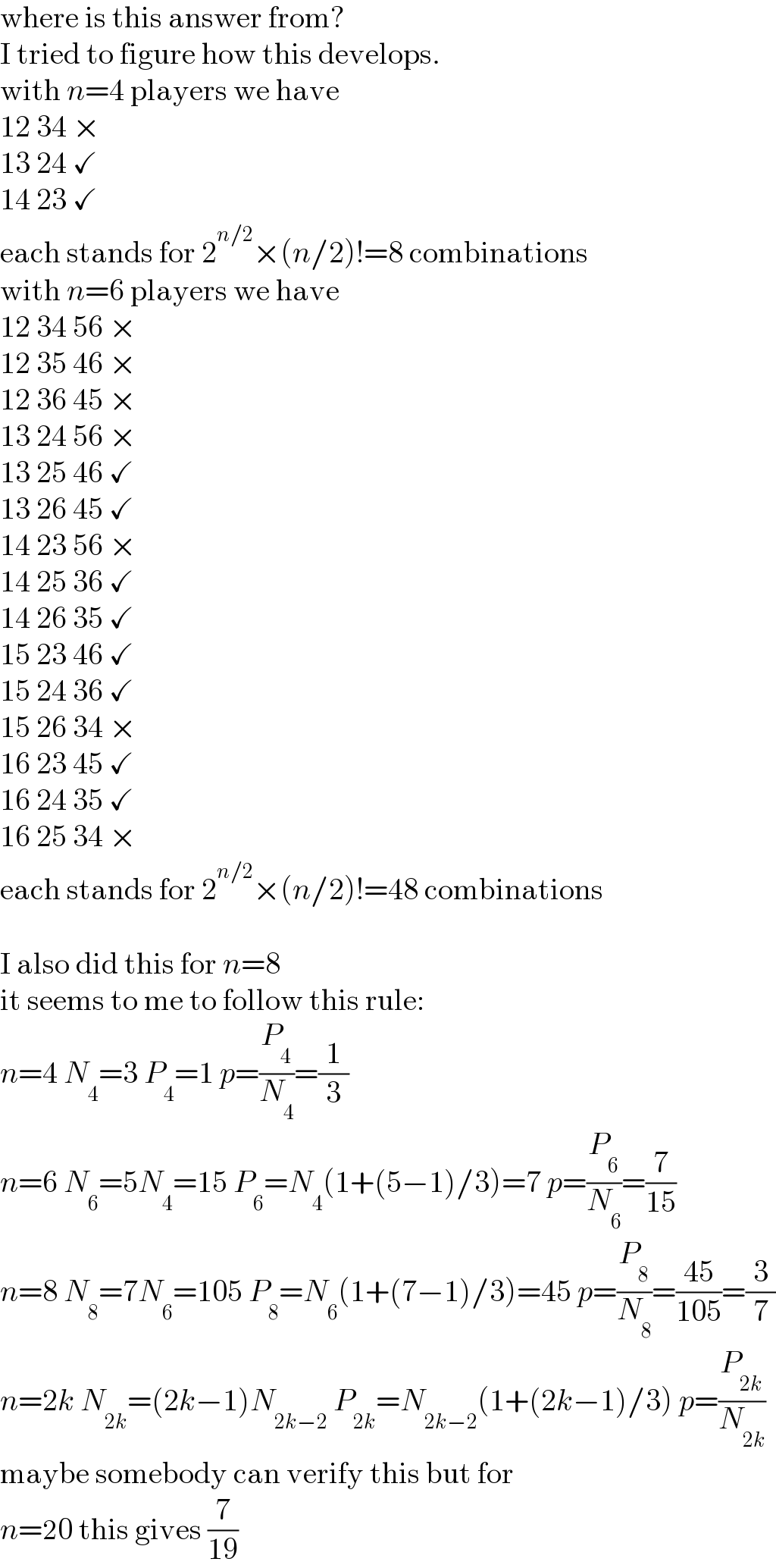
$$\mathrm{where}\:\mathrm{is}\:\mathrm{this}\:\mathrm{answer}\:\mathrm{from}? \\ $$$$\mathrm{I}\:\mathrm{tried}\:\mathrm{to}\:\mathrm{figure}\:\mathrm{how}\:\mathrm{this}\:\mathrm{develops}. \\ $$$$\mathrm{with}\:{n}=\mathrm{4}\:\mathrm{players}\:\mathrm{we}\:\mathrm{have} \\ $$$$\mathrm{12}\:\mathrm{34}\:× \\ $$$$\mathrm{13}\:\mathrm{24}\:\checkmark \\ $$$$\mathrm{14}\:\mathrm{23}\:\checkmark \\ $$$$\mathrm{each}\:\mathrm{stands}\:\mathrm{for}\:\mathrm{2}^{{n}/\mathrm{2}} ×\left({n}/\mathrm{2}\right)!=\mathrm{8}\:\mathrm{combinations} \\ $$$$\mathrm{with}\:{n}=\mathrm{6}\:\mathrm{players}\:\mathrm{we}\:\mathrm{have} \\ $$$$\mathrm{12}\:\mathrm{34}\:\mathrm{56}\:× \\ $$$$\mathrm{12}\:\mathrm{35}\:\mathrm{46}\:× \\ $$$$\mathrm{12}\:\mathrm{36}\:\mathrm{45}\:× \\ $$$$\mathrm{13}\:\mathrm{24}\:\mathrm{56}\:× \\ $$$$\mathrm{13}\:\mathrm{25}\:\mathrm{46}\:\checkmark \\ $$$$\mathrm{13}\:\mathrm{26}\:\mathrm{45}\:\checkmark \\ $$$$\mathrm{14}\:\mathrm{23}\:\mathrm{56}\:× \\ $$$$\mathrm{14}\:\mathrm{25}\:\mathrm{36}\:\checkmark \\ $$$$\mathrm{14}\:\mathrm{26}\:\mathrm{35}\:\checkmark \\ $$$$\mathrm{15}\:\mathrm{23}\:\mathrm{46}\:\checkmark \\ $$$$\mathrm{15}\:\mathrm{24}\:\mathrm{36}\:\checkmark \\ $$$$\mathrm{15}\:\mathrm{26}\:\mathrm{34}\:× \\ $$$$\mathrm{16}\:\mathrm{23}\:\mathrm{45}\:\checkmark \\ $$$$\mathrm{16}\:\mathrm{24}\:\mathrm{35}\:\checkmark \\ $$$$\mathrm{16}\:\mathrm{25}\:\mathrm{34}\:× \\ $$$$\mathrm{each}\:\mathrm{stands}\:\mathrm{for}\:\mathrm{2}^{{n}/\mathrm{2}} ×\left({n}/\mathrm{2}\right)!=\mathrm{48}\:\mathrm{combinations} \\ $$$$ \\ $$$$\mathrm{I}\:\mathrm{also}\:\mathrm{did}\:\mathrm{this}\:\mathrm{for}\:{n}=\mathrm{8} \\ $$$$\mathrm{it}\:\mathrm{seems}\:\mathrm{to}\:\mathrm{me}\:\mathrm{to}\:\mathrm{follow}\:\mathrm{this}\:\mathrm{rule}: \\ $$$${n}=\mathrm{4}\:{N}_{\mathrm{4}} =\mathrm{3}\:{P}_{\mathrm{4}} =\mathrm{1}\:{p}=\frac{{P}_{\mathrm{4}} }{{N}_{\mathrm{4}} }=\frac{\mathrm{1}}{\mathrm{3}} \\ $$$${n}=\mathrm{6}\:{N}_{\mathrm{6}} =\mathrm{5}{N}_{\mathrm{4}} =\mathrm{15}\:{P}_{\mathrm{6}} ={N}_{\mathrm{4}} \left(\mathrm{1}+\left(\mathrm{5}−\mathrm{1}\right)/\mathrm{3}\right)=\mathrm{7}\:{p}=\frac{{P}_{\mathrm{6}} }{{N}_{\mathrm{6}} }=\frac{\mathrm{7}}{\mathrm{15}} \\ $$$${n}=\mathrm{8}\:{N}_{\mathrm{8}} =\mathrm{7}{N}_{\mathrm{6}} =\mathrm{105}\:{P}_{\mathrm{8}} ={N}_{\mathrm{6}} \left(\mathrm{1}+\left(\mathrm{7}−\mathrm{1}\right)/\mathrm{3}\right)=\mathrm{45}\:{p}=\frac{{P}_{\mathrm{8}} }{{N}_{\mathrm{8}} }=\frac{\mathrm{45}}{\mathrm{105}}=\frac{\mathrm{3}}{\mathrm{7}} \\ $$$${n}=\mathrm{2}{k}\:{N}_{\mathrm{2}{k}} =\left(\mathrm{2}{k}−\mathrm{1}\right){N}_{\mathrm{2}{k}−\mathrm{2}} \:{P}_{\mathrm{2}{k}} ={N}_{\mathrm{2}{k}−\mathrm{2}} \left(\mathrm{1}+\left(\mathrm{2}{k}−\mathrm{1}\right)/\mathrm{3}\right)\:{p}=\frac{{P}_{\mathrm{2}{k}} }{{N}_{\mathrm{2}{k}} } \\ $$$$\mathrm{maybe}\:\mathrm{somebody}\:\mathrm{can}\:\mathrm{verify}\:\mathrm{this}\:\mathrm{but}\:\mathrm{for} \\ $$$${n}=\mathrm{20}\:\mathrm{this}\:\mathrm{gives}\:\frac{\mathrm{7}}{\mathrm{19}} \\ $$
Commented by Frix last updated on 24/Oct/22

$$\mathrm{but}\:\mathrm{your}\:{p}\:\mathrm{is}\:\mathrm{the}\:``\mathrm{wrong}\:\mathrm{side}'',\:\mathrm{you}\:\mathrm{must} \\ $$$$\mathrm{take}\:\mathrm{1}−{p} \\ $$
Commented by MJS_new last updated on 24/Oct/22

$$\mathrm{yes}\:\mathrm{you}'\mathrm{re}\:\mathrm{right} \\ $$
